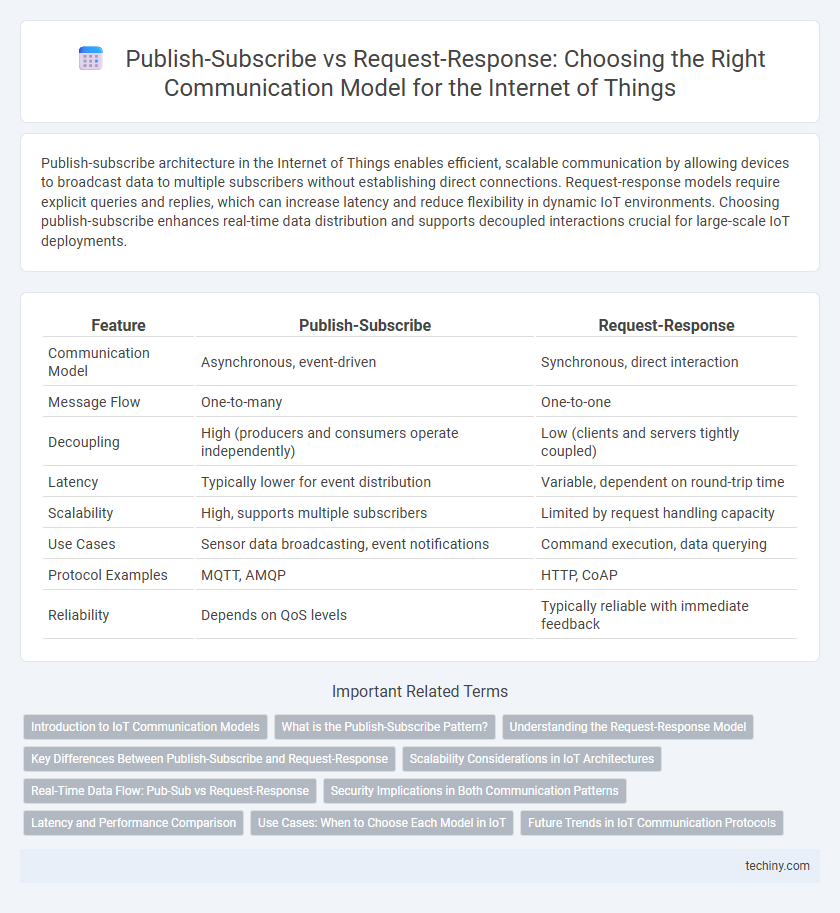Publish-subscribe architecture in the Internet of Things enables efficient, scalable communication by allowing devices to broadcast data to multiple subscribers without establishing direct connections. Request-response models require explicit queries and replies, which can increase latency and reduce flexibility in dynamic IoT environments. Choosing publish-subscribe enhances real-time data distribution and supports decoupled interactions crucial for large-scale IoT deployments.
Table of Comparison
| Feature | Publish-Subscribe | Request-Response |
|---|---|---|
| Communication Model | Asynchronous, event-driven | Synchronous, direct interaction |
| Message Flow | One-to-many | One-to-one |
| Decoupling | High (producers and consumers operate independently) | Low (clients and servers tightly coupled) |
| Latency | Typically lower for event distribution | Variable, dependent on round-trip time |
| Scalability | High, supports multiple subscribers | Limited by request handling capacity |
| Use Cases | Sensor data broadcasting, event notifications | Command execution, data querying |
| Protocol Examples | MQTT, AMQP | HTTP, CoAP |
| Reliability | Depends on QoS levels | Typically reliable with immediate feedback |
Introduction to IoT Communication Models
IoT communication models primarily include Publish-Subscribe and Request-Response, each serving distinct data exchange needs in networked devices. The Publish-Subscribe model operates on asynchronous messaging where devices publish data to topics, enabling multiple subscribers to receive updates without direct requests, optimizing scalability for sensor networks. Request-Response follows a synchronous pattern, ideal for direct command and control interactions where a device sends a request and awaits a specific response, ensuring reliable, real-time communication in IoT systems.
What is the Publish-Subscribe Pattern?
The Publish-Subscribe pattern in the Internet of Things (IoT) enables devices to communicate asynchronously by decoupling message producers (publishers) from consumers (subscribers) through a message broker. This pattern supports scalable and flexible data distribution by allowing multiple subscribers to receive relevant updates without direct requests, enhancing network efficiency and reducing latency. Common protocols implementing this pattern include MQTT and AMQP, which facilitate lightweight, real-time communication in IoT ecosystems.
Understanding the Request-Response Model
The request-response model in the Internet of Things (IoT) operates through a direct communication method where a client sends a request and waits for a corresponding response from a server, ensuring synchronous interaction and immediate feedback. This model is ideal for IoT applications requiring guaranteed message delivery and real-time data exchanges, such as sensor data retrieval or device configuration. Understanding the request-response pattern highlights its suitability for environments with stable connectivity and defined query-response cycles, contrasting with the more decoupled publish-subscribe approach.
Key Differences Between Publish-Subscribe and Request-Response
Publish-subscribe architecture enables asynchronous communication where devices publish messages to topics and multiple subscribers receive relevant data, enhancing scalability and decoupling. Request-response, on the other hand, involves synchronous interactions with a direct query and reply pattern, suitable for real-time, point-to-point communication. Key differences include the communication model--one-to-many vs one-to-one--and timing, with publish-subscribe supporting event-driven notifications and request-response relying on immediate replies.
Scalability Considerations in IoT Architectures
Publish-subscribe architecture excels in scalability for IoT by enabling asynchronous communication and decoupling devices, which reduces network congestion and supports millions of connected sensors efficiently. Request-response models face limitations due to synchronous interactions, leading to increased latency and bottlenecks as device numbers grow. Scalability in IoT strongly benefits from publish-subscribe protocols like MQTT and AMQP that optimize resource management and allow dynamic subscription handling across distributed networks.
Real-Time Data Flow: Pub-Sub vs Request-Response
Publish-subscribe architecture enables real-time data flow by allowing devices to push updates instantly to multiple subscribers without waiting for requests, enhancing scalability and reducing latency in IoT networks. Request-response relies on periodic polling or direct queries, which may introduce delays and increase network overhead, limiting responsiveness in time-sensitive applications. Pub-sub protocols like MQTT and DDS optimize event-driven communication, making them ideal for real-time monitoring and control in IoT ecosystems.
Security Implications in Both Communication Patterns
Publish-subscribe communication in IoT enhances scalability but presents security challenges such as message interception and unauthorized subscriptions due to its decoupled architecture. Request-response models offer tighter security control through direct authentication and encryption between endpoints but can suffer from increased latency and reduced scalability. Implementing robust encryption protocols, access controls, and anomaly detection is critical in both patterns to mitigate risks like man-in-the-middle attacks and data tampering.
Latency and Performance Comparison
Publish-subscribe architectures in Internet of Things (IoT) systems typically offer lower latency and higher scalability due to their asynchronous, event-driven communication model that enables real-time data distribution to multiple subscribers. In contrast, request-response protocols often incur higher latency as each interaction requires a direct, synchronous exchange, which can become a bottleneck in large-scale IoT deployments. Performance-wise, publish-subscribe patterns reduce network congestion and improve resource utilization by decoupling message producers and consumers, making them more suitable for latency-sensitive and high-throughput IoT applications.
Use Cases: When to Choose Each Model in IoT
Publish-subscribe is ideal for IoT use cases requiring real-time data distribution to multiple devices, such as smart home automation and environmental monitoring, because it supports asynchronous communication and scalability. Request-response suits scenarios demanding direct, immediate feedback, like device management or firmware updates, where reliability and synchronous interactions are critical. Selecting between these models depends on application needs for latency, device count, and communication patterns within the IoT ecosystem.
Future Trends in IoT Communication Protocols
Publish-subscribe protocols such as MQTT and CoAP are increasingly favored in IoT for their scalability and efficient event-driven communication, supporting millions of connected devices with minimal latency. Request-response models, exemplified by HTTP, remain critical for direct device management and control but face limitations in real-time responsiveness and network overhead. Future IoT communication trends emphasize hybrid protocols that combine the asynchronous efficiency of publish-subscribe with the reliability of request-response, enhanced by edge computing and AI for adaptive, context-aware data transmission.
Publish-subscribe vs Request-response Infographic

 techiny.com
techiny.com